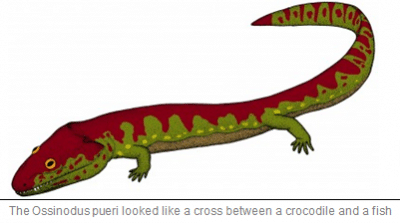Australian fossil forces rethink on ancestors’ emergence onto land’

The first backboned animals to step out of water and walk on dry land were from Australia, a new study has found.
Previously it was thought that the first terrestrial vertebrates were small animals from Scotland. However analysis of a 333 million year old broken bone by researchers from Monash University, Queensland University of Technology (QUT) and the Queensland Museum, published in the journal PLoS One, suggests otherwise and pushes back the date of the first terrestrial vertebrates by two million years.
The findings shed new light on a question that has vexed paleontologists for decades – how and when backboned animals with four legs came out of the water and started living on land.
The team studied the fossil remains of a very primitive amphibian, called Ossinodus pueri, which looked like a cross between a crocodile and a fish. Significantly older and much larger than the fossils found in Scotland, the Ossinodus was found in 2001 near the central Queensland town of Emerald.
One of the fossils, a 4cm long arm bone, which had fractured in life and had started to heal when the animal died, was re-examined using CT scans, allowing the team to ‘look inside’ the fossil. Scans of the bone revealed that its internal microstructure was consistent with what was expected for an animal that spent time walking on land.
Applying the same principles that engineers use to assess whether a building or bridge is adequately supported, the team developed a three-dimensional computer model of the bone. They then used engineering computer software to determine what kinds of forces were needed for the bone to break in a manner consistent with that seen in the fracture.
The simulations indicated that for the bone to break, the animal would have experienced a very large impact force, exceeding five times its own body weight.
Peter Bishop from the Queensland Museum said that a fall on land was the most likely explanation for the broken arm bone.
“Forces of that relative magnitude don’t happen easily in water, because water cushions against forces, especially impact forces. In order to fall down, the Ossinodus must have been on land to begin with,” Peter Bishop said.
Dr Matthew Phillips from QUT said the age of the fossil raises the possibility that the first animals to emerge from the water to live on land were large tetrapods in Gondwana in the southern hemisphere, rather than smaller species in Europe.
“This specimen of Ossinodus is our oldest vertebrate ancestor shown biomechanically to have spent significant time on land. It is two million years older than the previous undoubtedly terrestrial specimens found in Scotland, which were less than 40cm long.”
The research team found other features that confirmed the tetrapod had spent substantial time on land. The internal bone structure was consistent with re-modelling during life in accordance with forces generated by walking on land. They also found evidence of blood vessels that enter the bone at low angles, potentially reducing stress concentrations in bones supporting body weight on land
Dr Cathrine Boisvert from the Australian Regenerative Medicine Institute (ARMI) at Monash University said their discovery highlights the significant role that Australian fossils play in understanding the history of life on the planet.
“Other, older tetrapods are known from elsewhere in the world, but it is unclear if they were capable of supporting themselves on land,” she said.
“With Ossinodus, however, we can say with great confidence that this creature was walking on land 333 million years ago,” Dr Boisvert said.
Researchers believe the findings highlight the value of combining studies on palaeontology, biomechanics and pathology to understand how extinct organisms lived.
The research is published in the freely available international journal PLoS One, and the fossil specimen is housed in the Geosciences Collection of the Queensland Museum.
